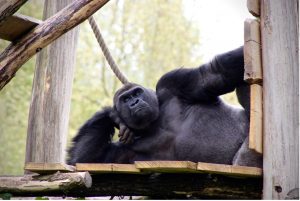Dear blog reader, this month, we are delighted to be welcoming Maithri Sivaraman to the series. As you will see, Maithri’s work and research story really exemplify the fruits of the collaborative and cooperative exercise we outlined in our blog last month. In her own words, Maithri is “… a mechanical engineer turned behavior analyst, in a clinical psychology lab, planning to study early social behaviors in children.” But don’t take our word for it: read on and see for yourselves! We hope you enjoy it as much as we did and start to get a fuller picture of, and appreciation for, the collaborative effort we are all trying to encourage with the current series.
Colin and Dermot
 About the author:
About the author:
Maithri Sivaraman is a doctoral student in Psychology at Ghent University in Belgium. Prior to this position, she established the Tendrils Centre for Autism in Chennai, India. Her research focusses on social and verbal behavior development in children, and cultural considerations in the dissemination of behavior analysis.
Cross-Domain Scientific Collaboration: A Gorilla on the Basketball Court
Psychologists Daniel Simons and Christopher Chabris designed a classic experiment in which participants were made to watch a video of a basketball match between two teams – one team dressed in black, and the other in white. Participants were asked to count the number of passes made by the team in white, and ignore the team in black. Halfway through the video, a gorilla appears on the court, thumps its chest, and is visible for nearly nine seconds on screen. The psychologists observed that almost fifty percent of the participants did not notice the gorilla. “We are often blind to our own blindness”, Dr. Daniel Kahneman wrote reflecting on the experiment. In this post, I reflect upon my own research journey as a doctoral student  at Ghent University, and the instrumental role that collaboration across scientific disciplines has played in treating my “blindness”. Specifically, I will describe how a collaborative approach to research has spawned interesting research questions, experimental methods, and data analysis techniques which might otherwise not have emerged at all.
at Ghent University, and the instrumental role that collaboration across scientific disciplines has played in treating my “blindness”. Specifically, I will describe how a collaborative approach to research has spawned interesting research questions, experimental methods, and data analysis techniques which might otherwise not have emerged at all.
When I decided to quit my job as a BCBA in India and pursue my PhD, I came across Dr. Herbert Roeyers’ group at Ghent University which focuses on developmental trajectories and behavioral and biological markers for developmental disorders. A few Skype appointments and a successful grant application later, I moved to Belgium and started off as his PhD student – a mechanical engineer turned behavior analyst, in a clinical psychology lab, planning to study early social behaviors in children. I met Dr. Javier Virues-Ortega, around the same time, at that year’s ABAI conference in San Diego, who agreed to lend his expertise in behavior analysis to my research as my remote co-supervisor.
With my mentors’ expertise in psychology and behavior analysis influencing me, I first started studying the development of social referencing in infants using a longitudinal design. Social referencing typically develops around 12-months of age and is said to be a key component of early communication and a prerequisite for later language acquisition. A research design with time as the independent variable, though not the traditional choice for behavior analysts, gave me a fine-grained view of the developmental sequence of the behaviors I was interested in. Our measures highlighted the specific deficits in social referencing in children with an elevated likelihood for autism spectrum disorder (ASD) compared to typically-developing children at different time-points between the ages of 14 months – 36 months. Trajectories of behaviors and learning histories across time can be identified using waves of data from longitudinal studies, and if we were to rely exclusively on cross-sectional data, the findings could be misleading.
These developmental trajectories identified in the longitudinal study were instrumental in the development of a social referencing intervention for children with ASD. We designed an intervention using exemplar training and tested it by collaborating with early intervention centers in the Flanders region of Belgium. The intervention was delivered by rehabilitation professionals (psychologists, speech therapists) with no formal training in behavior analysis. We used a mixed experimental design – a randomized clinical trial with a multiple baseline design nested in the experimental group to evaluate the effects of the intervention. Single-case designs have often been criticized for being subject to patient selection bias and not accommodating mainstream inferential statistics, and behavior analysts have rejected statistical comparisons for the mismatch between statistical and clinical significance. Our nested research design permitted evaluations to be conducted at the individual-level and the group-level. This meant that the analyses led to a widely intelligible summary of results that are considered acceptable across research domains, a quantification of the magnitude of effects, and robust measures of social and clinical significance for individual participants using visual analysis techniques.
 The longitudinal study that I described earlier also afforded me the opportunity to study the behavioral mechanisms underlying social referencing. Discriminated responding is said to be at the core of social referencing. During early infant-caregiver interactions, the caregiver orients the child towards a particular stimulus and encourages the child to approach “safe” and avoid “dangerous” stimuli. These interactions also typically involve the caregiver smiling and cooing in the presence of toys or familiar people, or showing displeasure and warning signs in the presence of dangerous items. We designed a discrimination test that involved infants reaching towards one of two specific toys. Reaching towards one of the toys resulted in happy music being played, while reaching towards the other resulted in aversive sounds and the caregiver looking away from the child. An index of discrimination learning calculated using the number of approach responses towards each stimulus (i.e., the toys associated with positive vs. aversive music) provided a measure of the strength of the behavioral processes involved, and how they compared with standard social referencing data collected across time. If a longitudinal study is not a traditional choice for a behavior analyst, then a discrimination learning test is not a traditional choice for a clinical psychologist. The combination of these research methods, seemingly at cross-roads, yielded a means to study and answer previously unposed questions.
The longitudinal study that I described earlier also afforded me the opportunity to study the behavioral mechanisms underlying social referencing. Discriminated responding is said to be at the core of social referencing. During early infant-caregiver interactions, the caregiver orients the child towards a particular stimulus and encourages the child to approach “safe” and avoid “dangerous” stimuli. These interactions also typically involve the caregiver smiling and cooing in the presence of toys or familiar people, or showing displeasure and warning signs in the presence of dangerous items. We designed a discrimination test that involved infants reaching towards one of two specific toys. Reaching towards one of the toys resulted in happy music being played, while reaching towards the other resulted in aversive sounds and the caregiver looking away from the child. An index of discrimination learning calculated using the number of approach responses towards each stimulus (i.e., the toys associated with positive vs. aversive music) provided a measure of the strength of the behavioral processes involved, and how they compared with standard social referencing data collected across time. If a longitudinal study is not a traditional choice for a behavior analyst, then a discrimination learning test is not a traditional choice for a clinical psychologist. The combination of these research methods, seemingly at cross-roads, yielded a means to study and answer previously unposed questions.
I then moved towards coordinated attention between caregivers, children, and objects which is thought to play a critical role in early word learning. The behaviors that involve coordinated attention are often described as joint attention, social referencing, and gaze following. In clinical psychology, these behaviors are seen as the “social bases” for language development (Tomasello, 1992). In behavior analysis, they are seen as pre-verbal foundational cusps (Greer & Keohane, 2005); and as early acts of cooperation unique to humans, and fundamental for the emergence of arbitrarily applicable relational responding (Hayes & Sanford, 2014; Pelaez, 2009). Collaboration between disciplines that are traditionally cordoned off into separate academic units may be precisely what is needed to start a dialogue, reconcile differing perspectives, and ultimately, add to the precision, scope, and depth of scientific inquiry. In the case of coordinated attention, these behaviors are defined largely topographically and there are key variations in the definitions and measurement methods used across studies. Perhaps, adopting a functional perspective may be beneficial, or even necessary, to make inroads in this area.
The next stage in my research led me to Dr. Dermot Barnes-Holmes’ office one February afternoon, after one of his students encouraged me to discuss my research with him. I got to spend hours learning about Relational Frame Theory (RFT), and how it could inform my previous work on early social behaviors. I also got a glimpse into the cutting-edge research on updated-RFT that was being carried out at Dr. Barnes-Holmes’s lab. He eventually introduced me to Dr. Douglas Greer, the pioneer of Verbal Behavior Development Theory (VBDT) and his work on bidirectional naming, which at first glance seemingly takes a different stance to RFT.
RFT and VBDT are two behavior-analytic theories on language development that have several similarities but currently exist largely in “parallel universes.” Both theories seek to identify frameworks and empirical research strategies to study behavioral phenomena such as equivalence, naming, and problem solving. Although each theory uses its own terminology, these terms often do not appear to differ fundamentally in the types of functional-analyses that they generate. For example, VBDT researchers describe bidirectional naming as the conjoining of the speaker and listener repertoires and the establishment of naming as a verbal developmental cusp that provides a child with new ways to learn. RFT researchers would likely describe bidirectional naming in terms of an object and its name forming a response unit in the presence of specific contextual cues (labelled Crels and Cfuncs). In the case of naming, these cues establish the relationship between the object and its name (i.e., coordination) and determine how to respond (e.g., “point to” versus “what is this?”). The RFT account would thus describe the conjoining of the two repertoires of listener and speaker as occurring when the Crel properties of the two stimuli coordinate and the Cfunc properties cohere. The two accounts thus appear to be articulating similar functional-analytic ideas using different terms, but essentially seem to agree about the behavioral histories involved.
A collaborative approach between the two theories could yield research questions that currently remain unanswered and ultimately further the science. One such attempt could be to conceptualize naming as a derived relation. Where previous studies on naming have presented the object and its name simultaneously during both training and testing, it could be argued that no derived or emergent responding is required during a test for naming. That is, when an object is presented to a child and its name is uttered simultaneously in the presence of the object, a bi-directional relation between the object and name may be established directly; from the child’s perspective, they see-object/hear-name and hear-name/see-object. Subsequently, during a listener trial if a child is asked to point to the named object, there is no need to invoke a derived or emergent relation to explain a correct response. It seems important to control for the direct training of name-object bidirectional relations in order to interpret naming as a derived relation involving the conjoining of speaker and listener repertoires. One way to do this could be to present the object, and then hide it from view before it is named. This way, the object-name relation is trained, and the name-object relation can be tested.
Our ongoing study aims to control for this possibility by presenting the object and the name sequentially and non-simultaneously. All our participants (typically-developing toddlers with a mean age of 18 months) failed to emit naming responses during the initial test. Subsequently, four participants received multiple exemplar training, which led to improvements in listener naming for all four, and speaker naming for one participant. Participants who were tested repeatedly, without multiple exemplar training, did not show any consistent improvements in their listener or speaker performances. If naming responses emerge when a non-simultaneous presentation technique is used, then at the very least, a derived bidirectional relation can be theorized. A collaborative approach across theories could allow for greater precision in identifying and explaining the underlying behavioral processes.
 Each scientific discipline comes with its unique ways of organizing enquiry, yet there is a striking commonality in our endeavor towards identifying new ways to build, use, and interpret the science of behavior. In developmental psychology, scientific investigations typically involve longitudinal studies in which time is the independent variable, and they aim to describe the temporal sequence or trajectories involved in the emergence of a series of behaviors. Behavior analysis aims to describe events and behaviors while also identifying frameworks and processes that could aid in manipulating these behaviors to predict and control organism-environment interactions. The differences across disciplines seem to be less in the outcomes that we are interested in, and more in how we get to the outcomes. A unifying goal that brings disciplines together is our combined effort to build the relationship between individuals and the science. In our pursuit of scientific knowledge, we must remember to keep an eye out for the gorilla!
Each scientific discipline comes with its unique ways of organizing enquiry, yet there is a striking commonality in our endeavor towards identifying new ways to build, use, and interpret the science of behavior. In developmental psychology, scientific investigations typically involve longitudinal studies in which time is the independent variable, and they aim to describe the temporal sequence or trajectories involved in the emergence of a series of behaviors. Behavior analysis aims to describe events and behaviors while also identifying frameworks and processes that could aid in manipulating these behaviors to predict and control organism-environment interactions. The differences across disciplines seem to be less in the outcomes that we are interested in, and more in how we get to the outcomes. A unifying goal that brings disciplines together is our combined effort to build the relationship between individuals and the science. In our pursuit of scientific knowledge, we must remember to keep an eye out for the gorilla!
References
Greer, R. D., & Keohane, D.-D. (2005). The evolution of verbal behavior in children. Behavioral Development Bulletin, 12(1), 31-47. http://dx.doi.org/10.1037/h0100559
Hayes, S. C., & Sanford, B. T. (2014). Cooperation came first: Evolution and human cognition. Journal of the Experimental Analysis of Behavior, 101, 112–129. https://doi.org/10.1002/jeab.64.
Pelaez, M. (2009). Joint attention and social referencing in infancy as precursors of derived relational responding. In R. A. Rehfeldt & Y. Barnes-Holmes (Eds.), Derived relational responding: Applications for learners with autism and other developmental disabilities (pp. 63–78). New Harbinger.
Tomasello, M. (1992). The social bases of language acquisition. Social Development, 1(1), 67-87. https://doi.org/10.1111/j.1467-9507.1992.tb00135.x
